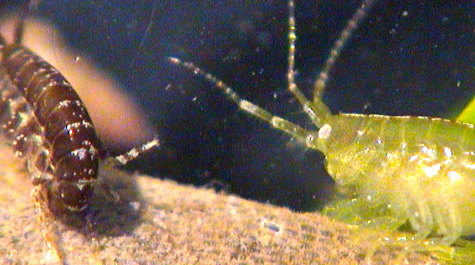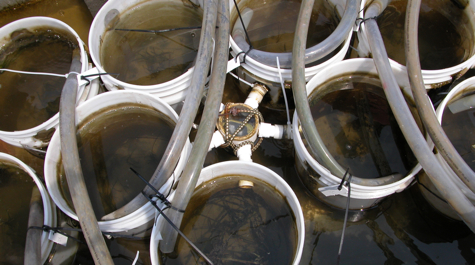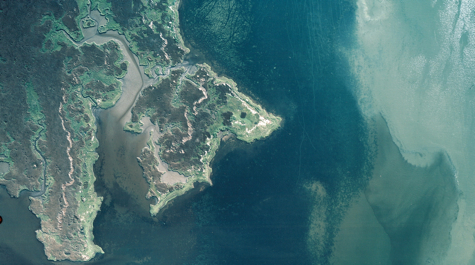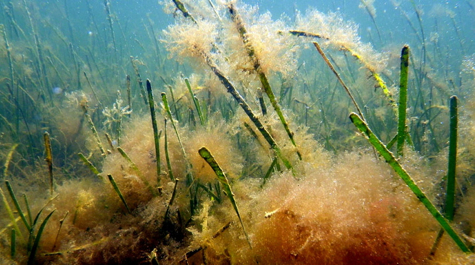VIMS professor wins NSF grant for global seagrass experiment
Professor Emmett Duffy of the Virginia Institute of Marine Science has received a 3-year, $728,000 grant from the U.S. National Science Foundation to establish a global experimental network for studying how nutrient pollution and changes in biodiversity impact seagrass beds.
The ultimate goal of the international research project is to generate knowledge that will help improve the computer models and management strategies that are increasingly used to predict and manage change in the world’s coastal zones.
Research at VIMS and elsewhere shows that seagrasses play a key role in the health and vitality of coastal ecosystems, providing a home for important fish and shellfish species, limiting erosion, soaking up nutrients, and helping to improve water clarity. Scientists estimate the value of these “ecosystem services” in the trillions of dollars per year. The research also shows that seagrasses are experiencing a troubling decline in most coastal ecosystems around the world.
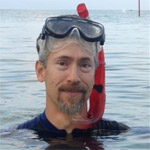 Duffy, Loretta and Lewis Glucksman Professor of Marine
Science at VIMS, says the new project builds on a series of small-scale seagrass
experiments that he has conducted at VIMS during the last decade with graduate
students and technicians in his Marine Biodiversity Lab.
Duffy, Loretta and Lewis Glucksman Professor of Marine
Science at VIMS, says the new project builds on a series of small-scale seagrass
experiments that he has conducted at VIMS during the last decade with graduate
students and technicians in his Marine Biodiversity Lab.
In these “mesocosm” experiments, designed to ask what happens to productivity and nutrient cycling when species are lost, the researchers manipulate the number and kinds of grazers and predators within small tanks containing seagrass and algae. The grazers are different species of small, shrimp-like crustaceans called amphipods. Blue crabs and fishes serve as the predators.
The idea, says Duffy, is to mimic as closely as possible the conditions within a real seagrass bed, while also allowing for manipulation of selected variables to help understand the dynamics of this complex system.
Duffy’s mesocosm experiments—and similar ones done elsewhere—show that increasing the number of grazer species in a tank leads to an increase in the total number of grazers, while decreasing the amount of algae. In short, says Duffy, “mesocosm experiments show that increased grazer diversity leads to a healthier, more productive seagrass ecosystem.” The grazers benefit the seagrasses by eating the algae that otherwise grows on and shades the grass blades.
The experiments also reveal what ecologists call a “trophic cascade,” a domino-like effect in which adding a level to a food chain—in this case a blue crab predator—leads not only to decreased numbers of the predator’s prey (amphipods) but then to an increased abundance of the prey’s preferred food (in this case the algae that the amphipods like to eat).
From Plastic to Planet
Duffy now wants to test these findings in the real world, or as he puts it, “to move our experiments from 5-gallon plastic buckets to the planetary scale.” An important goal of this real-world research is to determine the “context specificity” of the biodiversity effect. “In other words,” he asks, “are there particular environmental conditions under which diversity is more or less important?”
Duffy’s NSF funding will help answer that question by supporting manipulation experiments in eelgrass beds at 14 sites around the world, including in Japan, along the East and West coasts of the U.S., and up the Atlantic coast of Europe from Portugal to Norway.
The experiments will all use the same design and methods, including a new technique to allow for experimental manipulation of plots within actual seagrass beds, rather than in mesocosms. Using the same methods at each site will allow the researchers to attribute any observed differences in their results to the effect of the local environment and to geographic gradients in biodiversity, rather than the experimental design.
The project will involve close collaboration among marine ecologists and graduate students at VIMS, the University of Algarve (Portugal), Åbo Akademi University (Finland), Norwegian Institute of Water Research, College of Charleston, Northeastern University, Université du Québec à Chicoutimi, San Diego State University, University of California Davis, University of Washington, University of Alaska, and Hokkaido University (Japan).
In addition to shedding light on “context specificity,” the new research will help answer another, related question: the relative importance of biodiversity as compared to other environmental factors such as water temperature, salinity, and current velocity; and to the availability of nutrients and other resources.
“After doing mesocosm experiments for a number of years, we’ve become interested in moving beyond the question of whether diversity’s important—which has now been answered with a ‘yes’—to asking how important is it relative to other kinds of influences,” says Duffy.
Structural Equation Modeling
To quantify and compare the relative importance of all these different influences —each acting within a complex, real-world ecosystem—will require the use of a new statistical technique called “structural equation modeling” or SEM.
Duffy says the SEM approach “is really promising for these complex system interactions.” “It will help us bring the experimental variables and the abiotic, environmental variables together to determine the relative importance of grazer diversity, composition, and biomass, compared to various forcing factors.”
Dr. Jim Grace, a U.S. Geological Survey researcher who has literally written the book on structural equation modeling (Grace, J.B. 2006. Structural Equation Modeling and Natural Systems. Cambridge University Press), will visit VIMS in December to assist Duffy and others at VIMS in applying the method to their studies.


